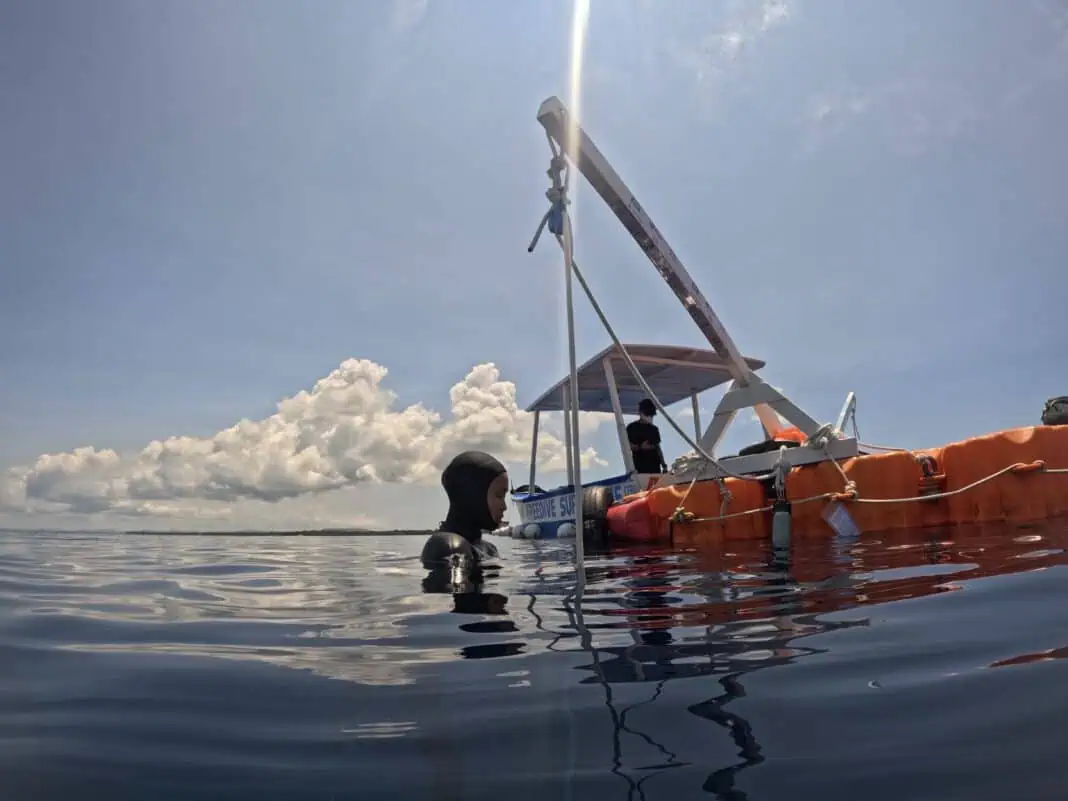Winter is the off-season for freediving in Taiwan, which means we head abroad for our deep freediving training.
I had particular conditions in mind for my training at the end of 2023:
- Warm – I’ll never be excited about training in colder water
- Deep – A minimum 70m (230ft) of depth, but ideally more available
- Low cost of living – I wanted to stay for 3+ months
I started asking around within my freediving friend group, and the name “Freedive SuperHOME” kept popping up. Everyone was repeating the same things: very affordable, amazing scheduler, and big freediving community.
Freedive SuperHOME is located on the small island of Panglao in the Philippines. I already knew that the Philippines has a relatively low cost of living and enjoys temperate waters year-round, with the coldest being 26°C (79°F) and the warmest being 31°C (88°F). I was also told that the world’s deepest freedivers went there to train, and that SuperHOME was the home of the Asian Freediving Cup, the largest depth competition in Asia. This was more than enough information to convince me to try it for the season.

So, I contacted SuperHOME, booked my tickets, and began looking for accommodation while packing my gear (P.S. check out this interactive freediving packing list I created for freediving trips!).
Dive Site
Freedivers who want to train autonomously must be certified AIDA 4/Wave 3 (or equivalent) or higher and undergo a one-time assessment by a SuperHOME safety.
SuperHOME has two options for freedivers to train autonomously:
- Drift diving with a buoy (limited to dives 89m / 292ft or shallower for safety)
- Diving off their platform (up to 200m / 656ft of depth)
Both options require a very short boat ride from SuperHOME’s location on Doljo Beach, a 5- to 10-minute ride out to train on a buoy or a 5-minute ride to the platform.
Buoy diving
Drift diving on a buoy with SuperHOME is gloriously effortless.
First of all, who doesn’t love diving without a current? The visibility, at its lowest, was 15m (33ft) for the first few days I was there. After that, the worst was 20m (66ft) in the 4 months I spent there, with the best being the days I could see the green lanyard stopper at an incredible 35m (115ft) of depth.
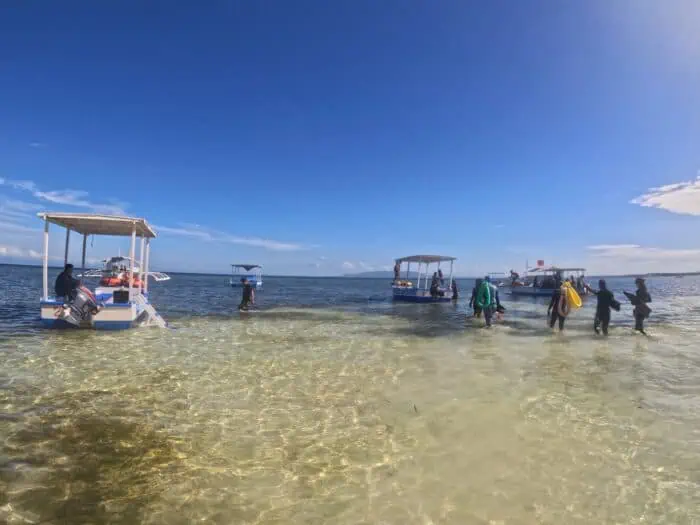
Outside of Panglao’s best months to train (May – July), waves with whitecaps are a possibility. This wasn’t the norm for me, though; significant waves were only present for a handful of my training days. Either way, my humble opinion is that freedivers should be comfortable diving in less-than-ideal conditions, so I like a bit of surprise on my dives (as long as it’s not current!).
The jellyfish can be annoying, but it’s important to remember they’re also a natural and largely unavoidable part of the ocean. You’ll see plenty of freedivers wearing gloves, and I think tons of zinc or a face buff will not only protect you from the sun but also the stings of the sea’s more… peskier… inhabitants.
Platform diving
I’ve dived off of SuperHOME’s platform a few times, and it’s fabulous, especially for my deeper FIM dives.
There are six lines on the platform, spaced well apart from each other. These lines are more stable than diving off the buoy, which made FIM feel like a dream—plus, it was lovely to be able to sit on the platform to warm up between dives! It’s just a little more expensive than buoy diving (and sometimes they upgrade you at no extra cost!). You can also book your platform session to include counter ballast, sonar, dedicated safety, or a complete competition setup for an additional fee.
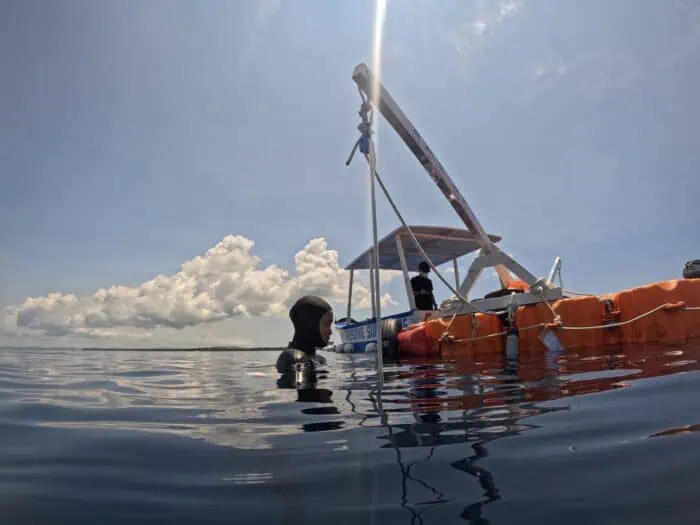
The platform enjoys the same conditions as buoy diving does, except, of course, that the current becomes a possibility. However, I only experienced some light shallow current on my dives (which disappeared past 10 – 15m / 33 – 49ft), and other freedivers told me that’s also the strongest it got for them.
Boat captains
The boat captains are the absolute heroes of the training sessions.
They’re true professionals: they drive the boats, set the line for you at the beginning/in the middle of a session if you need it, pull up the line up at the end of the session, watch out for you and other buoys the entire time, and spot and grab equipment that floats away from you. At no time do you’ve to set up, rinse off, or disassemble your buoy—they’ve got that covered. Pretty fantastic, right?
Honestly, I felt like a freediving princess there, and knowing I’d soon have to leave SuperHOME and face the harsh reality of setting up and transporting my equipment again was the only negative!
SuperHOME Scheduler
Their scheduler needs its section, as it’s one of the most extraordinary things I’ve ever seen from a freediving center.
To sign up for depth training sessions, using the pool, or using a classroom, you use the scheduler. For depth, you make an appointment for a morning or afternoon session the day before diving; you can include 1 or 2 buddies’ names to ensure you’re diving together, and can request a heavier bottom weight for FIM, pulley (I’ve never not had a pulley there), bottom plate with tags, and/or a larger buoy.
If you’re alone, no worries! The scheduler pairs you up with others who dive to similar depths. If you wake up feeling unwell, you can cancel free of charge before 8:00 a.m., and the scheduler will rearrange the dives so your buddy (ies) can still dive.
If that’s not a fantastic setup, especially for solo freedivers who come to train, I don’t know what is.
Safety
SuperHOME prioritizes safety, which is likely why many of the world’s top freedivers train there.
As mentioned above, if you need platform diving, safety divers, a counterbalance, and/or sonar, each is available for an additional fee. On the buoys, divers going deep will either have three people on their buoy or be attached to another buoy. All their boats have emergency and deco oxygen, and, of course, more is available back at the facility.
In the event of an emergency requiring immediate medical attention, SuperHOME provides its transportation to take you to ACE Medical Center, a hospital located approximately 30 minutes away. While a hyperbaric chamber is located a 7-minute drive from SuperHOME, it’s not currently operational as of February 2025. The nearest chamber is located on the island of Cebu, approximately 110 km (68 mi) away via a ferry from Panglao.
Facilities
The facilities at SuperHOME are airy, plentiful, and well-equipped.
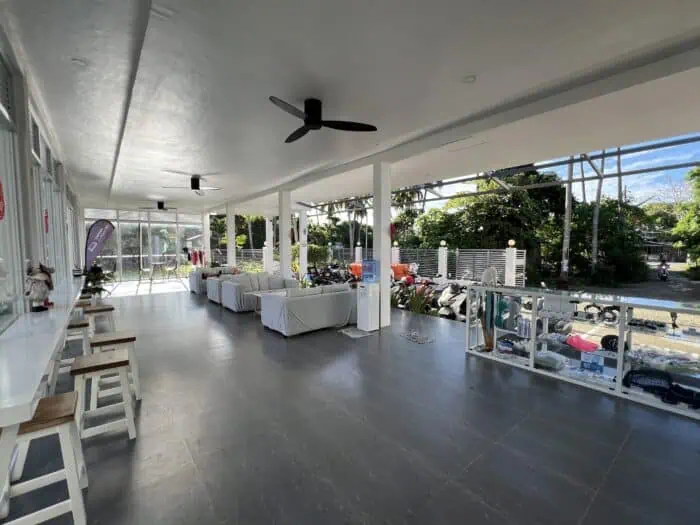
The reception area is situated in a bright and spacious lobby, where freedivers often gather and enjoy coffee after their training sessions.
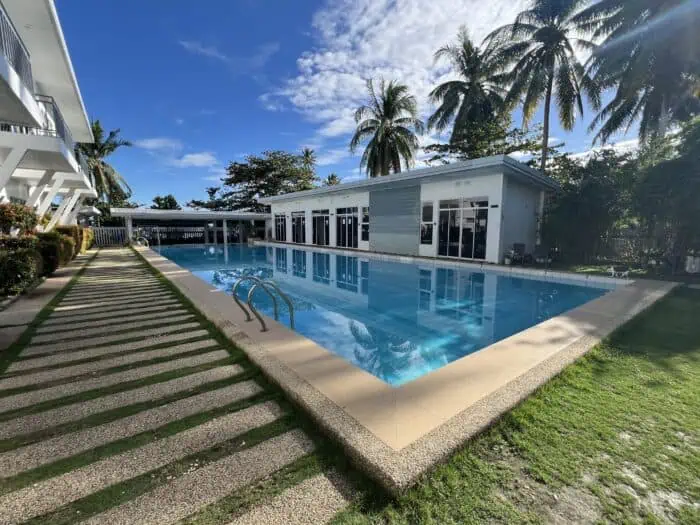
Right on the other side of the lobby’s floor-to-ceiling windows is the 25m pool, which contains four lanes that can house a maximum of 8 people at a time. They even offer on-site accommodations, though I stayed elsewhere during my visit and can only speak to their training facilities.
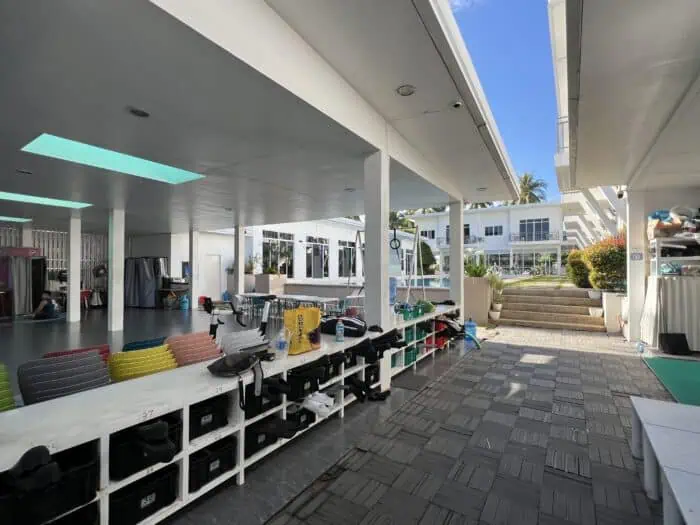
There are two indoor gear rooms and an outdoor gear storage area, where every freediver receives a box to store their equipment and fins. There are racks to hang your wetsuits in both places (however, I suggest taking wetsuits home to dry as mold is an almost unavoidable issue in tropical countries).

There’s also a vast, breezy dry area used for yoga classes, stretching, working out, and more.
SuperHOME’s shower area features 12 showers, which are typically quite warm due to the tropical climate. The men’s and women’s bathrooms each have two stalls, and there are also a few changing stalls located around the edges of the dry area. While the bathrooms are sufficient for non-peak periods, the peak periods, which include a large number of freedivers, may result in a wait to use the toilets.
Final Thoughts
Freedive SuperHOME honestly blows me away—there are so many reasons why:
- Great diving conditions
- Affordable buoy and platform training
- Top-notch and well-equipped facilities
- Innovative and efficient scheduler
- Professional and helpful facility staff and boat captains
- Thriving freediving community
But the most important reason I enjoyed freediving at SuperHOME is that I feel 100% confident that, if an emergency were to happen, their safety preparations and considerations, organization, and attention to detail would ensure the best possible outcome.
I will say that if you’re more of an introvert who prefers an intimate setting, SuperHOME during their peak diving season (May – July) may not be the ideal time to come, as the large amounts of competitions in Panglao (especially at SuperHOME) draw a lot of freedivers.
Yet, after spending 3 months at SuperHOME, it’s painfully obvious why it’s such a popular deep diving destination among freedivers training in Asia.
You don’t have to take my word for it, though—go see for yourself!

